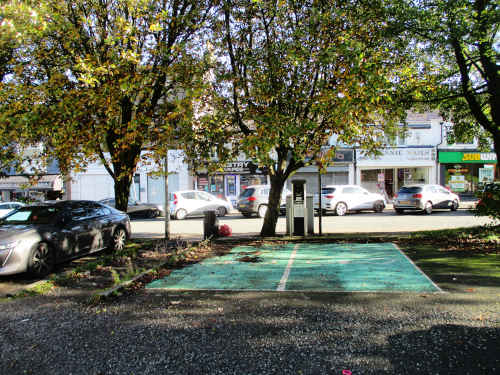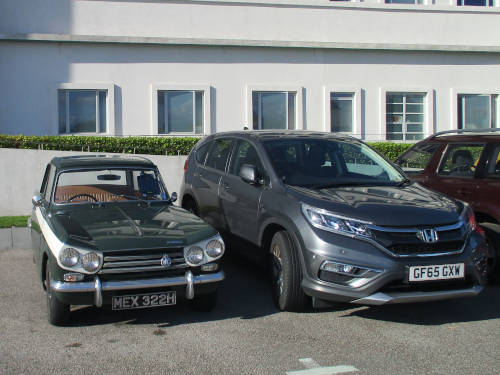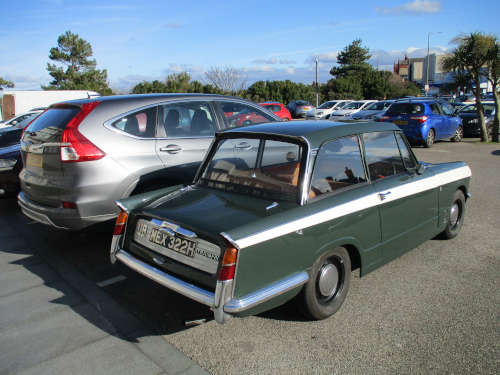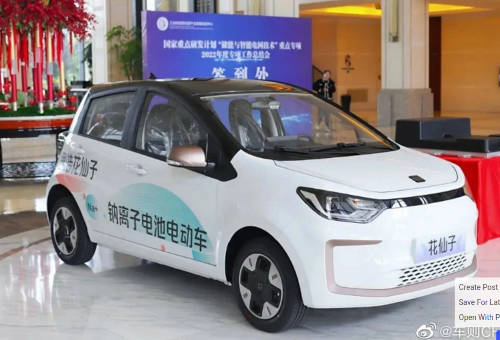Difficult by design?
This is Part 2. Part 1 is here
Angus Soutar
Why am I all revved up about cars? Leaving aside the fact that they tend to dominate many aspects of our lives, motor transport as a whole is a serious issue when it comes to creating a sustainable future. As with other aspects of modern life, it is a good strategy to look at our current situation and ask where the energy consumption is highest. Transport is the biggest use of energy in the UK - about 40 per cent of the total and the largest slice of the energy pie. Saving ten per cent on something that is 40 per cent of the total will save more energy than saving all of something that is only one or two per cent (e.g. agriculture). If we are serious about reducing our impact on the planet's vital systems, we need to address the energy use of our transport systems.
And problems lie not only with the energy consumption of road vehicles and the pollution they cause, it's the roads that they run along, too.
"The largest single factor in Britain causing loss of soils is the construction of highways. ... Highways account for the permanent loss of soils, as do cities." Bill Mollison "The terrible time of Day".
Society promotes "new-car crime"
As I mentioned previously, the ecological damage of driving a car is intensified by people who insist on driving a new car. Bringing a new car into existence causes long-term damage to the planet. A lot of people ignore the embodied energy of new things and the resource extraction involved. This applies to electric cars, too. Any public health benefits have to be offset against the shifting of pollution to somewhere else on the planet. I would argue that there are few reasons to feel virtuous about owning one of the current electric products, but I'll leave that until later. For now, let's just say that we have too much of a focus on the resources used in, and pollution caused by, running a car and not enough on its manufacture, maintenance, and subsequent demise.
These "new-car crimes" have been compounded by the positioning of cars as a consumer product, complete with built-in obsolescence. To paraphtase Tim Morgan, we continue to pile up the scrapyards of our dissipative landfill economy . Nigel Stewart raised this issue some time back in Northern Edge when he was musing on consumer engineering as it has become applied to houses. It's been the same with cars. The plethora of "choice" of new vehicles is not really a choice at all, just a mono-culture of consumer products supported by gallons and gallons of debt finance. And, as I mentioned earlier, governments happily collude in manipulating the market to keep it that way.
For most of us motorists and would-be car owners, being aware of the problem only makes things worse. Too many of us pressured into committing travel eco-crimes every day. To live a normal and productive life many of us must use our cars because there is no reasonable alternative. Already gnawed with gullt about interacting "normally" with Society, we find that the authorities are now blaming us failing to act "responsibly". Punsihment follows, in the form of restrictions, taxes and tolls, all falling disproportionately on poorer people, struggling small businesses and frugal OAP's.
 |
 |
Coercion of individual motorists is a poor and lazy approach. Effective solutions will come out of systemic change at societal level, not from petty rules and restrictions. Permaculture reminds us that the problem carries its own solution: we need to reduce the number of miles travelled and also the number of cars on on the roads. I'm convinced that this will eventually happen, one way or the other, The Great Simplification is coming. (And likely it will not be in the way that you or I, nor the powers-that-be, expect).
But what can we do now? Well, the answer to progress might not be more progress, but a gradual unwinding of the excesses of modernity. What has worked in the past may yet work in the future.
A "people's car"
How far has industry and government got with the green movement mantra: Reduce, Repair, Reuse, Recycle? Unlike some of the current "green" memes, this one fits well with permaculture philosophy. It points us towards a future transition through energy descent. I live by the basic principle that my cars, like all the other material things that I own, need to have long, long life.
Over a hundred years ago, Henry Ford led the design team credited with the first mass-produced vehicle, the Model T Ford.
“I will build a motor car for the great multitude. It will be large enough for the family but small enough for the individual to run and care for. It will be constructed of the best materials, by the best men to be hired, after the simplest designs that modern engineering can devise. But it will be so low in price that no man making a good salary will be unable to own one – and enjoy with his family the blessing of hours of pleasure in God’s great open spaces.” Henry Ford
Introduced in 1908, it was spectacularly successful. Production lasted until 1927 by which time 15 million of the "Tin Lizzies" had been produced The success was in part due to Ford's ruthless approach to standardisation, fighting his own sales force over customisation "There is a tendency to keep monkeying with styles and to spoil a good thing by changing it."
Unfortunately, as the Ford Motor Company powered through the 20th century they realised that the virtues of reliability and longevity meant that their profits would become unreliable and unsustainable. Consumer Engineering was on the rise, often hiding behind the more respectable Value Engineering which began to take hold throughout the industry. But there were contemporary King Canuts who would attempt to reverse the tide.
A noteable example was the German Volkswagen 1 - "the people's car" - which re-badged as the Beetle became an even longer-lived model and even more successful than Ford's "Tin Lizzie". Designed by a team led by Ferdinand Porsche, the designers had a clear outline specification similar to Ford's (in this case it was a "diktat" from a totalitarian government, possibly Hitler himself). The team's brief was to produce a car that was affordable, reliable and easy to maintain. Their German engineerng met and surpassed the initial requirements and re-validated the Henry Ford approach. First roaring off the production line 1938, the Beetle was in production and sold around the world until 2003.
Our British motor industry had its own success stories. The Morris Minor, first produced in 1948, had a twenty-odd year production run and I still see them running around some 50 years after production stopped. Some of them must be over seventy years old; that's the kind of lifetime I am looking for in a car. This deserves more attention I will write more about this particular design later.
Alec Issigonis led the design team that came up with the Minor at the Morris Motors company in Oxford. The same team went on to produce the iconic Morris Mini - another "economy" car first produced in 1956 and then for a further 40 years. I'll leave it to others to sing its undoubted praises, for I am slightly too tall to drive them comfortably and slightly too old to have joined the boy-racers who were immediate Mini enthusiasts.
Although the design of each model was a team effort, Issigonis demonstrated an excellence in design throughout his career. I suspect that part of the success of those German and British design teams arose from the austerity of World War 2 and the years immediately preceding and following it. "War effort" demanded a frugal, functional and innovative approach from designers.
 |
 |
| Lively little 1960's number... | ...compared to today's big tanks |
| Compare the use of scarce resources | Compare the weight that needs to be moved around |
 |
 |
There is a fascinating spin-off with the Hindustan Ambassador which was basically the design for the Morris Oxford Series III a shorter-lived contemporary of the Minor and the Mini. But when the design was put into production by Hindustan Motors of West Bengal, the production lines ran for almost 60 years; it was still in production ten tears ago. The "Amby" became a people's car for India, suited to the condition of Indian roads and meeting the need for rugged and spacious vehicles.
Countless taxi drivers chose the Amby and for a good while it was the chauffeur-driven choice many top officials as well as a popular family car. One proud owner is reported as saying:
“It allowed those who could afford a car to have joy in ordinariness. Sturdy with immense space for allowing for the seating of family (and even the neighbours), it was a true car for the joint family.”
Eventually some of the initial design flaws, such as poor fuel economy, together with production problems and encroaching modernity (it began to look "old fashioned") all led to its eventual decline in popularity. But again, 50 plus years was a good run.
I am left wondering whether we will ever see similar examples of vehicle design and production again. In China, Anhui Jianghuai Automobile Company (JAC Motors) have recently announced the "Flower Fairy" (if I have the translation right). This is a compact runabout that defies the "settled science" of the rest of the world's motor industry by using a sodium-ion battery rather than a lithium one, and the car is designed to be "affordable". We shall have to wait and see whether the totalitarian regime of modern China can be tough enough to specify the next People's Car, but it looks like they could be heading in that direction.
 |
 |
Self-build cars?
If we are going to have a smooth energy descent, some of us will have to embrace some changes to the cars we drive and the way we use them. The occasional forlorn hope pops up from time to time: that some previous power-house city like Birmingham could revive the production of parts for a radically simple car that could be assembled from kits in any community, much the same as some people do self-build houses.
To achieve this fantasy, we would probably need another Henry Ford or an enlightened eco-fascist government. But we can draw up the design brief and I'll float the following for discussion. How about new cars designed for:
- ultra long life
- modular construction with plenty of spares available
- standard parts that can be used in other vehicles / other industries
- basic model without promoting frills or consumer extras
- "timeless" styling
- no encouragement to spend long hours in the vehicle
- minimum electrics/electronics
- minimal battery power (until the technology has been adequately developed).
- you can have any colour you want, as long as it's "green".
Sounds mad? Have a think about it from the point of view of energy and material resources. Meawhile, I will write more about a possible roll-back from car-mageddon.